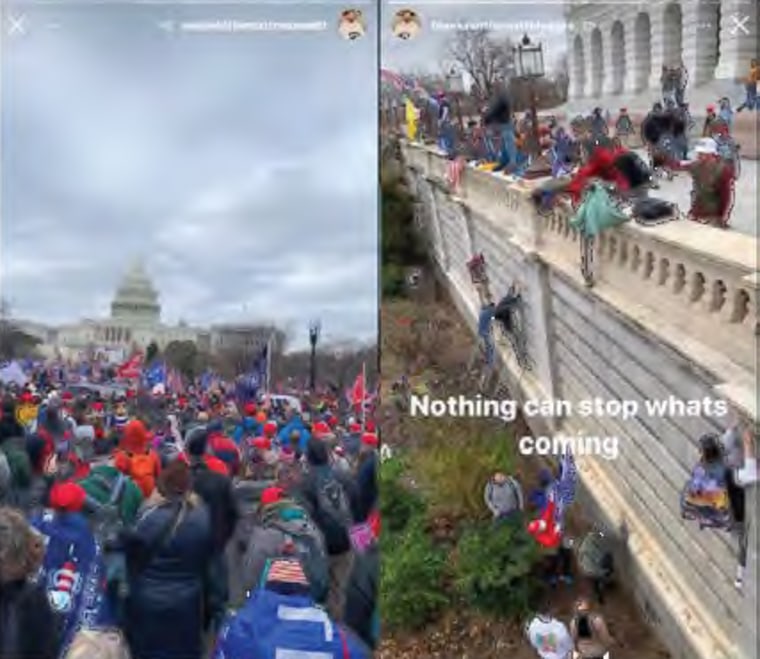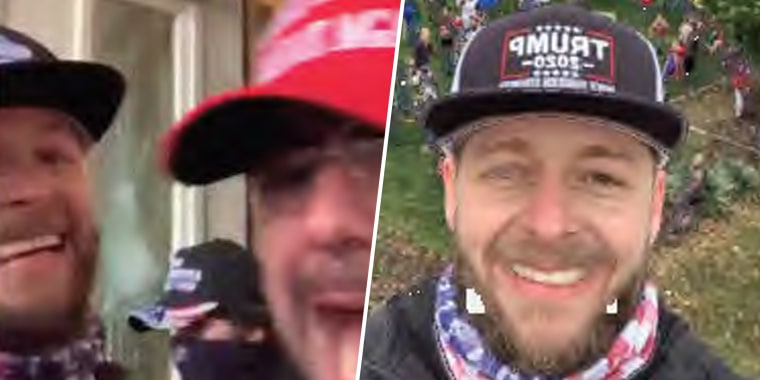WASHINGTON — A Tennessee man and self-described "loudmouth," who filmed himself screaming "WE IN THIS B----" as he stormed the U.S. Capitol on Jan. 6, 2021, had a difficult time explaining his actions this week to a jury.
Matthew Bledsoe, of Memphis, was convicted Thursday on a felony count of obstruction of an official proceeding as well as four misdemeanors, including entering or remaining in a restricted building and disorderly and disruptive conduct. Bledsoe, the seventh Jan. 6 defendant to face a jury trial, took the stand as a witness on Wednesday.
In closing statements Thursday, his lawyer, Jerry Ray Smith, argued that jurors should find him guilty of one misdemeanor offense, parading or picketing inside the Capitol, but not guilty on the other counts.
The trial unfolded as media attention at the federal courthouse in D.C. zeroed in on the contempt of Congress trial of Steve Bannon, a Trump ally and former White House strategist who refused to comply with a subpoena for documents and testimony from the House select committee investigating Jan. 6.
Bledsoe argued that he was unaware that Congress was certifying Joe Biden's 2020 election win when he stormed the Capitol. Despite having received updates from his wife and brother about congressional proceedings inside the Capitol on the day of the riot, he told jurors that he had no idea what lawmakers were doing. Former President Donald Trump’s speech at the Ellipse, which preceded the riot, also mentioned the electoral college certification process.
As he entered the Capitol through a door with broken glass panels, Bledsoe filmed himself saying, "Where are those pieces of s--- at." Alarms were blaring in the background of the video.
"Who were the pieces of s---?" Assistant U.S. Attorney Jamie Carter asked Bledsoe Wednesday. Bledsoe said he was "being a loudmouth," insisting he was not referring to lawmakers but rather the people whom he believed at the time had stolen an election.
Carter then showed an image that Bledsoe had reposted on social media that depicted members of Congress hunkered down inside the House amid the riot, with a caption suggesting that politicians should be scared.
Bledsoe said that it was "just something I reposted," and that he didn't have all the information at the time.
When prosecutors confronted him with a text he sent to his wife, saying it was "good" that someone planted bombs near the Capitol, Bledsoe said he really didn't mean "good." He also claimed he didn't really mean it when he wrote that he "stormed the Capitol."

In an attempt to explain why he climbed a wall to get to the Capitol, Bledsoe said his home in Tennessee was "quite a bit different" than D.C., and that he climbed walls back home regularly.
Bledsoe also claimed he couldn't hear Capitol alarms blaring on Jan. 6, or in the video he had filmed, which was replayed for the jury.
Carter told the jury Thursday that Bledsoe seemed to have a selective memory about what happened on the day of the riot.
"Seems he didn't see the things that could hurt him in his case today," Carter said, encouraging jurors to take Bledsoe at his own words. "He meant what he said, he said what he meant."
"You do not 'storm' somewhere you have a right to be. I don't 'storm' my friend's house when I go over for dinner," Carter said. "He said he stormed the Capitol, and he meant it."
Bledsoe’s attorney, who had conceded that his client showed "extremely poor judgement" and was "not completely blameless" for his actions, argued the government failed to prove beyond a reasonable doubt that Bledsoe went in with the intent to obstruct an official proceeding.
When Bledsoe saw tear gas inside the rotunda, the “scales fell from his eyes” and he realized for the first time that he was not welcome at the Capitol, Smith said.
The FBI has arrested about 850 defendants in connection with the Jan. 6 attack. More than 300 defendants have pleaded guilty and over 200 have already been sentenced.
The first six insurrection defendants to face a jury trial — Guy Reffitt, Thomas Robertson, Dustin Thompson, Thomas Webster, Timothy Hale-Cusanelli, and Anthony Robert Williams — were convicted on every count they faced. Other defendants have been convicted by judges during bench trials, and just one defendant has been fully acquitted.

